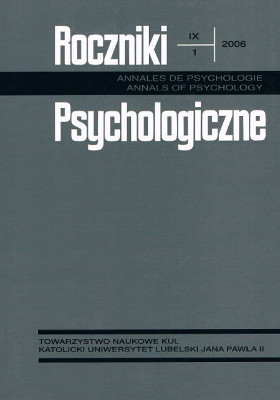Experience of numinosum, cognition of being and various ways to religion
Abstract
This article attempts at integration of the basic components of the concept of numinosum (as understood in the theological theory developed by R. Otto) and the attributes of cognition of Being (as understood in A. Maslow’s theory). It must be stressed that the both theoretical frameworks are complementary. Experience of numinosum (misterium tremendum) represents an invariant in terms of the manifested emotions and feelings, while cognition of Being involves the tendency to searching for, capturing and evaluation of a whole from the context of personal values. Four ways to religion (experience of numinosum) are described as related to different types of consciousness according to Jung’s theory of psychological types.
References
Hassie, R. R., Uleman, J. S., Bargh, J. A. (red.) (2005). The new unconscious, Cambridge: Cambridge Univewrsity Press.
Hick, J. (2005). Piąty wymiar. Odkrywanie duchowego królestwa. Poznań: Zysk i S-ka.
Joseph, R. (1992). The right brain and the unconscius. New York: Plenum Press.
Jung, C. G. (1995). Psychologia a religia. Warszawa: Wrota.
Jung, C. G. (1997). Typy psychologiczne. Warszawa: Wrota.
Kozielecki, J. (1991). Z Bogiem albo bez Boga. Psychologia religii: nowe spojrzenie. Warszawa: PWN.
Kuczkowski, S. (1998). Psychologia religii. Kraków: WAM.
Larus, D. (2004). Typ umysłu a przeżycie religijne (mps pracy magisterskiej, Katolicki Uniwersytet Lubelski).
Lieberman, M. D. (2000). Intuition: A social cognitive neuroscience approach. Psychological Bulletin, 126, 1, 109-137.
Lotz, J. (1983). Wprowadzenie w medytację. Kraków: WAM.
Maslow, A. (1986). W stronę psychologii istnienia. Warszawa: PAX.
Mistrz, Eckhard (1988). Kazania i traktaty. Warszawa: PAX.
Nosal, C. S. (2002a). Światy Junga i Poppera. ALBO albo, 3, 9-21.
Nosal, C. S. (2002b). Myślenie intuicyjne: fenomenologia i prawdopodobne mechanizmy. ALBO albo, 4, 27-41.
Oleś, P. (2003). Wprowadzenie do psychologii osobowości. Warszawa: Scholar.
Otto, R. (1993). Świętość: Elementy racjonalne i irracjonalne w pojęciu bóstwa. Wrocław: Thesaurus Press.
Pajor, K. (2002). Numinosum jako uczucie archetypowe. ALBO albo, 1, 69-84.
Pajor, K. (2004). Psychologia archetypów Junga. Warszawa: Eneteia.
Pinker, S. (2005). Tabula rasa. Spory o naturę ludzką. Gdańsk: GWP.
Popielski, K. (1994). Noetyczny wymiar osobowości. Lublin: Redakcja Wydawnictw KUL.
Prężyna, W. (1973). Intensywność postawy religijnej a osobowość. Lublin: Towarzystwo Naukowe KUL.
Prężyna, W. (1981). Funkcja postawy religijnej w osobowości człowieka. Lublin: Redakcja Wydawnictw KUL.
Unerwood, G. (red.). Utajone poznanie. Poznawcza psychologia nieświadomości. Gdańsk: GWP.
Waldenfels, H. (1984). Medytacja na Wschodzie i Zachodzie. Warszawa: Verbinum.
Wulff, D. M. (1999). Psychologia religii: klasyczna i współczesna. Warszawa: WSiP.
Zohar, D., Marshall, I. (2001). Inteligencja duchowa. Poznań: Rebis.
Copyright (c) 2006 Roczniki Psychologiczne

This work is licensed under a Creative Commons Attribution-NonCommercial-NoDerivatives 4.0 International License.


